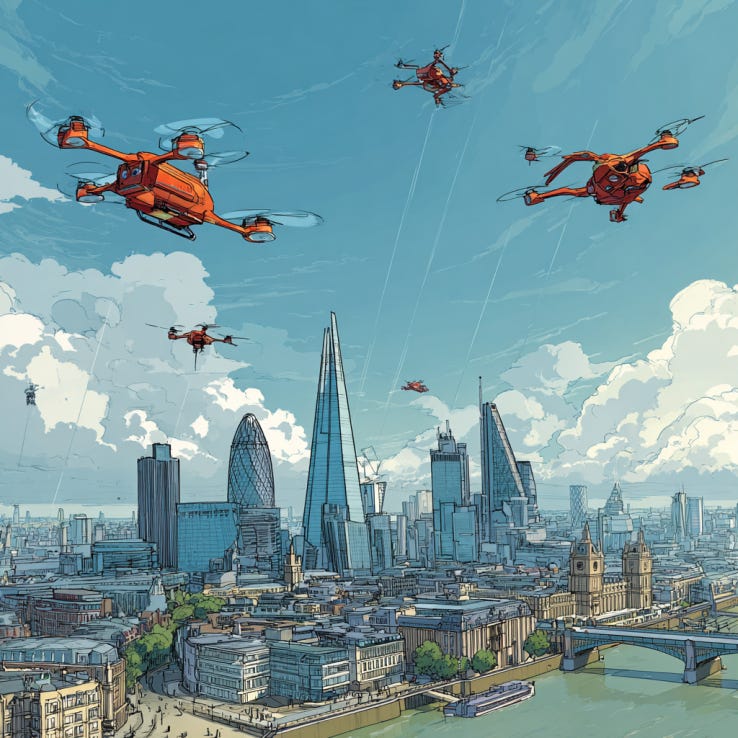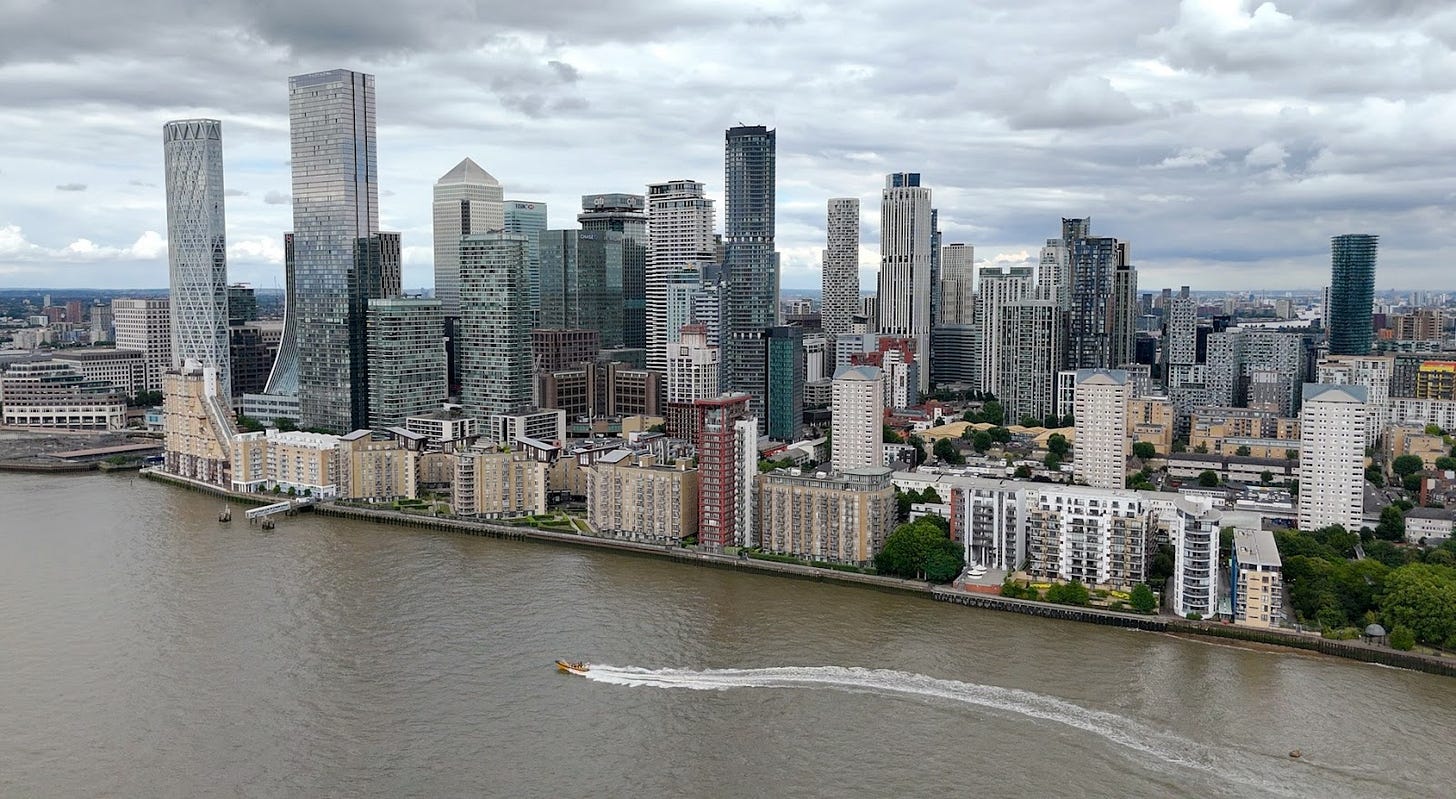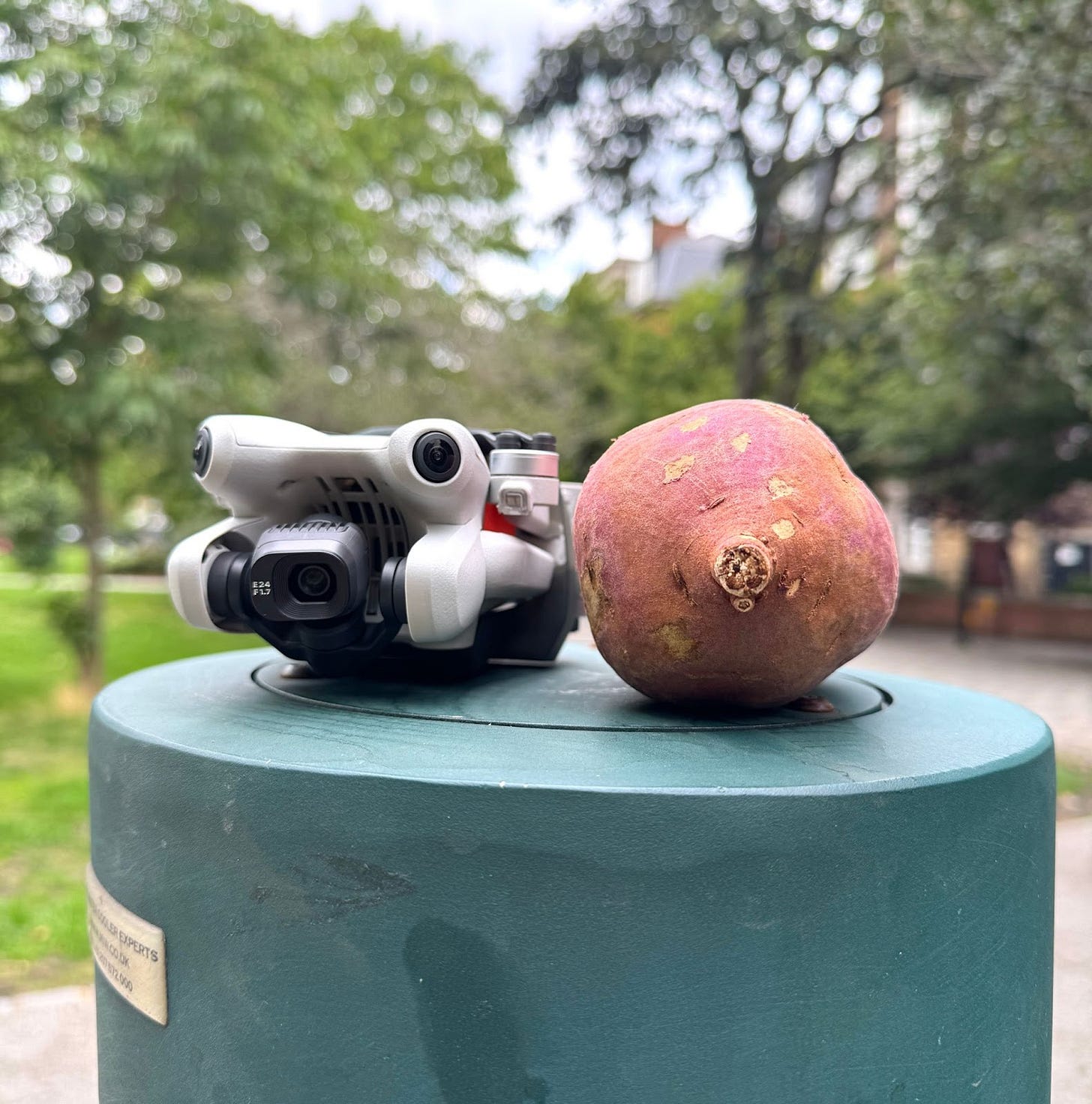Flying high
How to fly a drone in London
Written by Stuart Smith, broadcast journalist and founder of the London Drone Club, for the Greater London Project.
Modern drones are quiet and safe, and are piloted in cities the world over for both business and pleasure. But it’s hard to find places to fly in London, and it shouldn’t be.
You have just bought one of the most popular drone models ever made, the DJI Mini 4 Pro. It weighs less than 250g and is the length of a smartphone. The national aviation regulator allows you to fly it as high as the smoke stacks of Battersea Power Station or just below the height of the tallest pod on the London Eye , and as far away as you can see it. It comes packed with sensors that massively reduce the possibility pilot error could cause a crash. It can even autonomously return to where it took off and land by itself. Naturally, your first question, apart from perhaps how to fly it, is where you can fly it. With a modern drone in London, that’s the harder one to answer.

To understand where you can fly you need to understand that the airspace that the drone flies through is governed separately from where you stand to launch, control, and land the drone. This is why Easyjet doesn't need your permission to fly over your house. But the land is controlled by the landowner, which is why you can refuse Easyjet permission to land in your garden. A landowner can stop what happens on their ground but not what happens in the sky.
That privilege belongs to the Civil Aviation Authority (CAA) which manages UK airspace. The CAA goes to great lengths to consult with drone hobbyists and commercial drone users. Not everyone agrees with their decisions and changes, but they recognise the right of drone users to make use of the airspace and their contribution to society and the economy.
Drones are used by estate agents who fly through houses to give prospective buyers a greater sense of the property. Roofers can check what work is required without having to erect scaffolding. Mobile telecoms engineers can avoid the faff of blocking the road with a cherry-picker to inspect phone masts. And journalists can give readers and viewers with a new perspective on the city. The CAA acknowledges the industry represents a “healthy, fast-paced, highly-innovative” area. But many of London’s boroughs seem unconvinced.
Because to get your drone in the air you are going to have to take off from somewhere (and ideally land somewhere as well). But some of London’s local authorities have passed byelaws that prevent the flying of drones. It depends on the borough you are in, your definition of a drone, and what kind of land you want to take off from.
Take Croydon which, like Islington and Camden, has no restrictions on flying drones of any kind from any of its land. This means you just need to follow the CAA’s airspace rules, and can take off and land where you like. With the Mini 4 Pro, which is about the shape and half the weight of a medium-sized sweet potato, you can legally fly in the street, or in a park, close to buildings, or close to people.
But I have to travel to Croydon to fly my drone because where I live in Southwark flying a drone from a park is a violation of a byelaw they copied and pasted from a list of central government suggestions. These restrictions seem to have appeared in Southwark’s Parks and Open Spaces byelaws sometime around 2007. That is the year the first police drone was launched, described at the time as being derived from a military prototype that ‘only’ took 3 minutes to launch, was ‘only’ a metre wide, and was described variously in the press as an ‘unmanned helicopter’ and a ‘plane.’ More a large pumpkin than a sweet potato.
The byelaws used by boroughs to restrict the use of drones (often described as ‘model aircraft’ in the legislation) were not intended to regulate what a modern drone is. 2025’s consumer camera drones are very different to petrol-engine model aircraft. They are quieter, smaller, and safer than anything that existed at the time they were written. And now there is plenty of nationally consistent regulation controlling their use designed by qualified legal and aviation experts at the CAA.
Brent Council has taken regulation to the extreme. It prevents drones flying from all its parks and open spaces like many boroughs, but also take-off from land surrounding Wembley Park up to a kilometre away without prior written permission. Remember, the CAA can (and does) restrict flying during music and sports events around the stadium. But even if you want to land or take-off from your own garden within this radius when the stadium is empty, you need to run that by Brent Council first.
This is enforced through a Public Space Protection Order (PSPO) – an instrument designed to prevent anti-social behaviour that is “detrimental to the local community’s quality of life.” But asked with what evidence they relied on to determine whether they need a PSPO, Brent replied, “we do not have a number of incidences [sic.] recorded; but we have witnessed a number of people choosing to fly drones when it is perhaps too windy; in areas where there are high numbers of parks users.” They also noted in their reply that drone flights “can have really severe consequences for the safety of air passengers,” which is no doubt correct but is the CAA’s problem, not Brent Council’s.
Local authorities do not have the right expertise to regulate drone flight, and why should they? Let's leave the regulation to the national airspace regulator and if drone flights do become a problem in their parks or streets, council officers can use existing antisocial behaviour powers to fine inconsiderate drone users or call the police who can use their aviation powers to halt illegal flying.
If councils find there is a consistent problem with the use of drones in their public spaces, that genuinely meets the threshold of anti-social behaviour, they can still reimpose anti-drone byelaws. But this time with the appropriate evidence base to back them up, not hunches which date from nearly two decades ago. In the meantime London’s residents and businesses should be able to use this safer, useful, evolving, and exciting technology.




